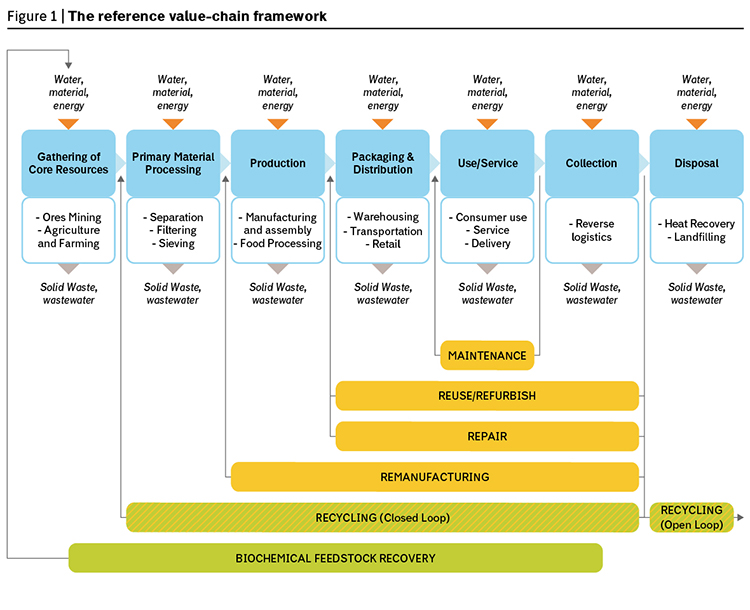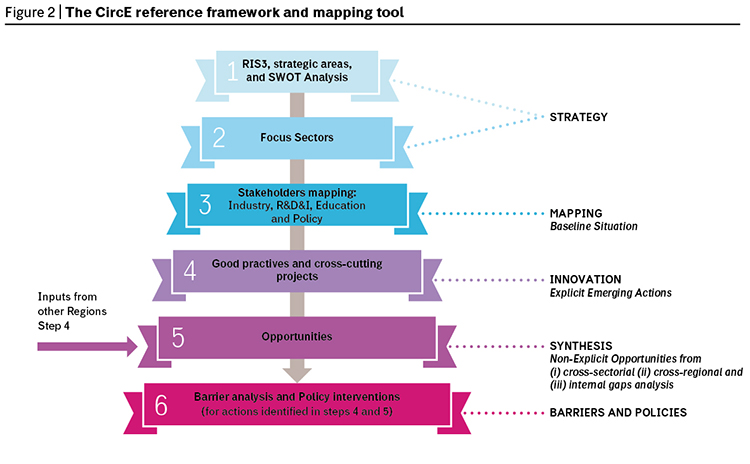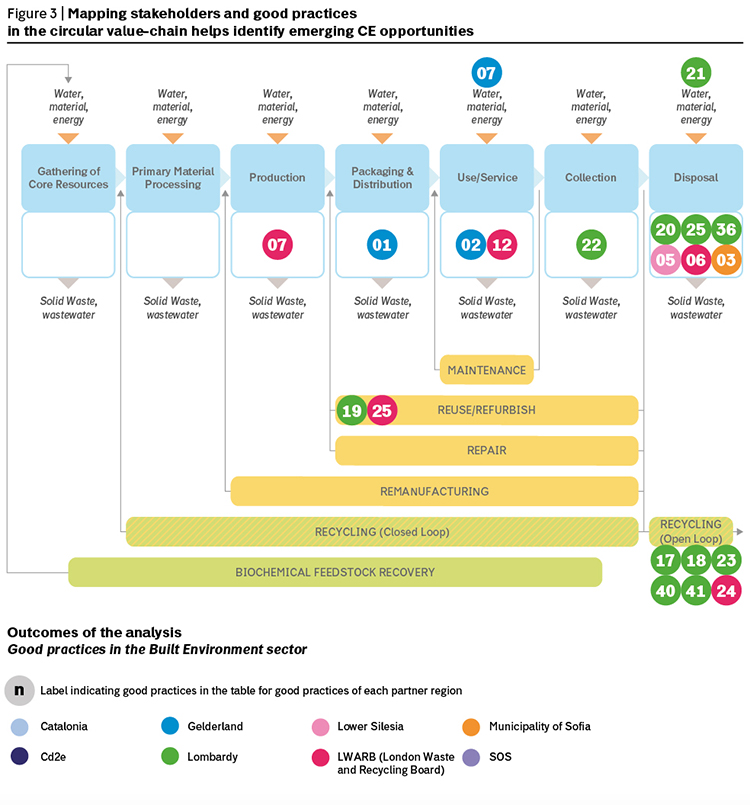The Circular Economy (CE) is on the tip of the tongue of politicians and business representatives across the European continent and beyond. However, quite often the real issue hindering the development of the CE is the lack of a unified framework to help identify regional and cross regional opportunities and potential barriers. On January 1st 2017 an important step towards tackling this issue was taken, whereby the CircE project emerged out of the Interreg Europe programme framework.
Thanks to this tool it has been possible to carry out “cross-regional” analysis (comparing the different partner regions relative to the same economic sector) and “cross-sectorial” analysis (evaluating the interrelations between the different economic sectors) involving 8 European partners.
The project’s success hinges on the CircE consortium’s design of a common methodology called the CircE mapping tool (CircE tool) that gathers information and maps existing stakeholder’s best practices, projects, CE opportunities, and the barriers that hinder their development. Highlighting gaps in circularity will make the CircE approach a reference model for European Institutions and policy makers, and help bring circularity centre stage.
CircE Tool – an Overview
TheCircE tool’s main objective is to define the current baseline CE situation in the CircE Regions by collecting data on strategies and existing mapping capabilities whilst remaining grounded in a value-chain oriented and integrated approach.
The data collection framework is inspired by the approach proposed by the Vanguard Initiative “New Growth through Smart Specialisation,” within the Efficient and Sustainable Manufacturing – ESM pilot. The reference value-chain framework to which the CircE tool adheres is reported in Figure 1. It also shares common ground with a companion project, Screen, funded by the Horizon 2020 Programme and also conforms with the approach suggested in the “Policymakers toolkit” proposed by the Ellen Mac Arthur foundation. The CircE tool is designed to tackle a specific part of the overall analysis.


Define the Regional Scenario With Respect to the CE
The first step or section of the tool is dedicated to the analysis of the strategic positioning of the region within a given area of the CE. This analysis is firstly addressed through the identification of the areas of Smart Specialisation (RIS3) of the region dealing with CE aspects, also so as to ensure the approach complies with the macro-objectives of the region.
Then, sectorial statistics are collected in order to define the role in the regional economy of the sector. Moreover, in order to represent the circularity potential for each sector, a set of circularity indicators/fields are identified. A further set of attributes are required which will be used to identify CE-related potential links with other sectors and regions, with the objective of supporting the value chain, cross-sectorial and cross-regional analyses.
Identify the Existing Regional Actors/Stakeholders and Their Capabilities
Once the strategic positioning of the region has been defined, the tool maps existing stakeholders in the region, with CE-related capabilities, including: Industry; Research, Development and Innovation (R&D&I); Education; and Policy-making entities. As a consequence, it triggers an analysis of the regional capabilities and expertise that address CE opportunities, thus combining the top-down approach of the strategic analysis with a bottom-up approach of the operational analysis.
For example, specific data is requested in order to define sectors of potential interest for the actors, the position in the circular value-chain, the technical capabilities related to the mapped role in the value-chain, and the input and output materials/components transformed. All of which is useful for identifying potential cross-sectorial value chain links.
The ability to identify the position within the value chain is a powerful tool, which helps spot links and stimulate cooperation between stakeholders who are active in the same target sector but work on a different position in the circular value chain.
Identify Good Practices and Projects
Subsequently, the CircE tool analysis moves on to describe closed and on-going CE projects and emerging good practices related to the Sectors and Stakeholders previously identified.
In the analysis of projects and good practices, particular attention is devoted to:
- the potential stakeholders who could form partnerships with the Stakeholder producing the Good Practice for the further exploitation and replication of the described good practice;
- the target sectors;
- the phase of the value-chain affected by the good practice;
- the Technology Readiness Level (TRL ) of the good practice, in order to understand its level of maturity.
Emerging Opportunities, Barriers and Policy Options
One of the most innovative aspects of the tool is the one dedicated to the collection of emerging opportunities, that synthetises latent and non-explicit Circular Economy opportunities derived by a cross-sectorial, cross-regional or internal gap identification analysis, and by exploiting the information on sectors, actors, good practices and projects, collected in the previous stages of the methodology.
For each opportunity more detailed information about the type of opportunity (e.g. industrial, R&D, innovation, policy making, education and training, social awareness) and the expected impact at economic, social and environmental level is required. This data will be useful for the future prioritisation of the opportunities in view of their implementation across the participating regions.
Connected to each opportunity, the tool also triggers a qualitative identification and analysis of the potential barriers hampering the defined opportunities. Different types of barriers are taken into consideration, belonging to the following main categories: economics, market failures, regulatory failures, social factors.
A set of policy options are proposed to identify the best ways with which to overcome barriers, belonging to the following categories: information & awareness, collaboration platforms, business support schemes, public procurement & infrastructure, regulatory framework, fiscal frameworks.
How the Tool Helps Identify Opportunities
The key area of the entire CircE tool methodology is the one dedicated to opportunity identification and mapping. In this part, a multi-regional and multi-sectorial analysis is run by CircE partners, using the combined analysis of all the regional data collected on sectors, actors, projects, good practices and opportunities. The opportunities are identified through different mechanisms:
Through an internal gap analysis, to a given region. In particular, these gaps can be identified in the analysis of sectors and good practices or during the exchange of experiences with other project partners.
Through a cross-sectorial or a cross-regional value chain analysis the opportunities emerge by linking opportunities, good practices, projects and stakeholders in different sectors or regions; in these cases, the value of inter-regional cooperation among stakeholders is crucial for implementing opportunities.
In order to support this analysis, the positioning in the value chain (Figure 1 – Circular Value Chain Framework) of all the data concerning actors, good practices, projects and opportunities is useful. This can be seen in Figure 3, where an example is provided concerning Project Partners’ good practices in a specific CircE sector (Built Environment).

The Strategic Benefit of the CircE Tool in Relation to Project Goals and Activities
The data collected within the CircE tool, will be the basis for the development of a strategic decision support system aimed at identifying priority of action among opportunities through a formalised approach. By weighting the opportunities in terms of impacts and evaluating the consequences and the suitability of policy options, a virtuous loop promoting the development of more and more effective circular economy initiatives by regional stakeholders can be established in the regions, coupled with the continuous monitoring of potential barriers and their removal.
The current pilot implementation of the CircE tool, and the related methodologies within the CircE consortium, represent a significant test of the approach and a valid decision support base for setting up CE policies within European regions. So far, the tool has made it possible to map 600 European stakeholders, 120 cross-cutting projects, 140 good practices, and identify 191 new regional opportunities and 40 cross-regional opportunities, thus generating confidence in the effectiveness and usability of the approach.
CircE, www.interregeurope.eu/circe
Screen, www.screen-lab.eu
Toolkit for Policymakers, tinyurl.com/ybx7nd9c


